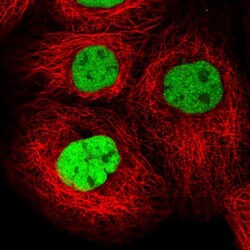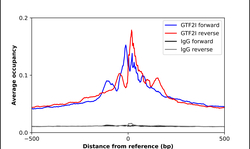HPA026638
antibody from Atlas Antibodies
Targeting: GTF2I
BAP-135, BTKAP1, DIWS, IB291, SPIN, TFII-I, WBSCR6
Antibody data
- Antibody Data
- Antigen structure
- References [1]
- Comments [0]
- Validations
- Immunocytochemistry [1]
- Chromatin Immunoprecipitation [1]
Submit
Validation data
Reference
Comment
Report error
- Product number
- HPA026638 - Provider product page

- Provider
- Atlas Antibodies
- Proper citation
- Atlas Antibodies Cat#HPA026638, RRID:AB_1857959
- Product name
- Anti-GTF2I
- Antibody type
- Polyclonal
- Description
- Polyclonal Antibody against Human GTF2I, Gene description: general transcription factor IIi, Alternative Gene Names: BAP-135, BTKAP1, DIWS, IB291, SPIN, TFII-I, WBSCR6, Validated applications: ChIP, ICC, IHC, WB, Uniprot ID: P78347, Storage: Store at +4°C for short term storage. Long time storage is recommended at -20°C.
- Reactivity
- Human
- Host
- Rabbit
- Conjugate
- Unconjugated
- Isotype
- IgG
- Vial size
- 100 µl
- Concentration
- 0.1 mg/ml
- Storage
- Store at +4°C for short term storage. Long time storage is recommended at -20°C.
- Handling
- The antibody solution should be gently mixed before use.
Submitted references Identification of proximal SUMO-dependent interactors using SUMO-ID
Barroso-Gomila O, Trulsson F, Muratore V, Canosa I, Merino-Cacho L, Cortazar A, Pérez C, Azkargorta M, Iloro I, Carracedo A, Aransay A, Elortza F, Mayor U, Vertegaal A, Barrio R, Sutherland J
Nature Communications 2021;12(1)
Nature Communications 2021;12(1)
No comments: Submit comment
Supportive validation
- Submitted by
- Atlas Antibodies (provider)
- Main image

- Experimental details
- Immunofluorescent staining of human cell line A-431 shows localization to nucleoplasm.
- Sample type
- Human
Supportive validation
- Submitted by
- Atlas Antibodies (provider)
- Main image

- Experimental details
- ChIP-Exo-Seq composite graph for Anti-GTF2I (HPA026638, Lot A106193) tested in K562 cells. Strand-specific reads (blue: forward, red: reverse) and IgG controls (black: forward, grey: reverse) are plotted against the distance from a composite set of reference binding sites. The antibody exhibits robust target enrichment compared to a non-specific IgG control and precisely reveals its structural organization around the binding site. Data generated by Prof. B. F. Pugh´s Lab at Cornell University.
 Explore
Explore Validate
Validate Learn
Learn Western blot
Western blot Immunocytochemistry
Immunocytochemistry